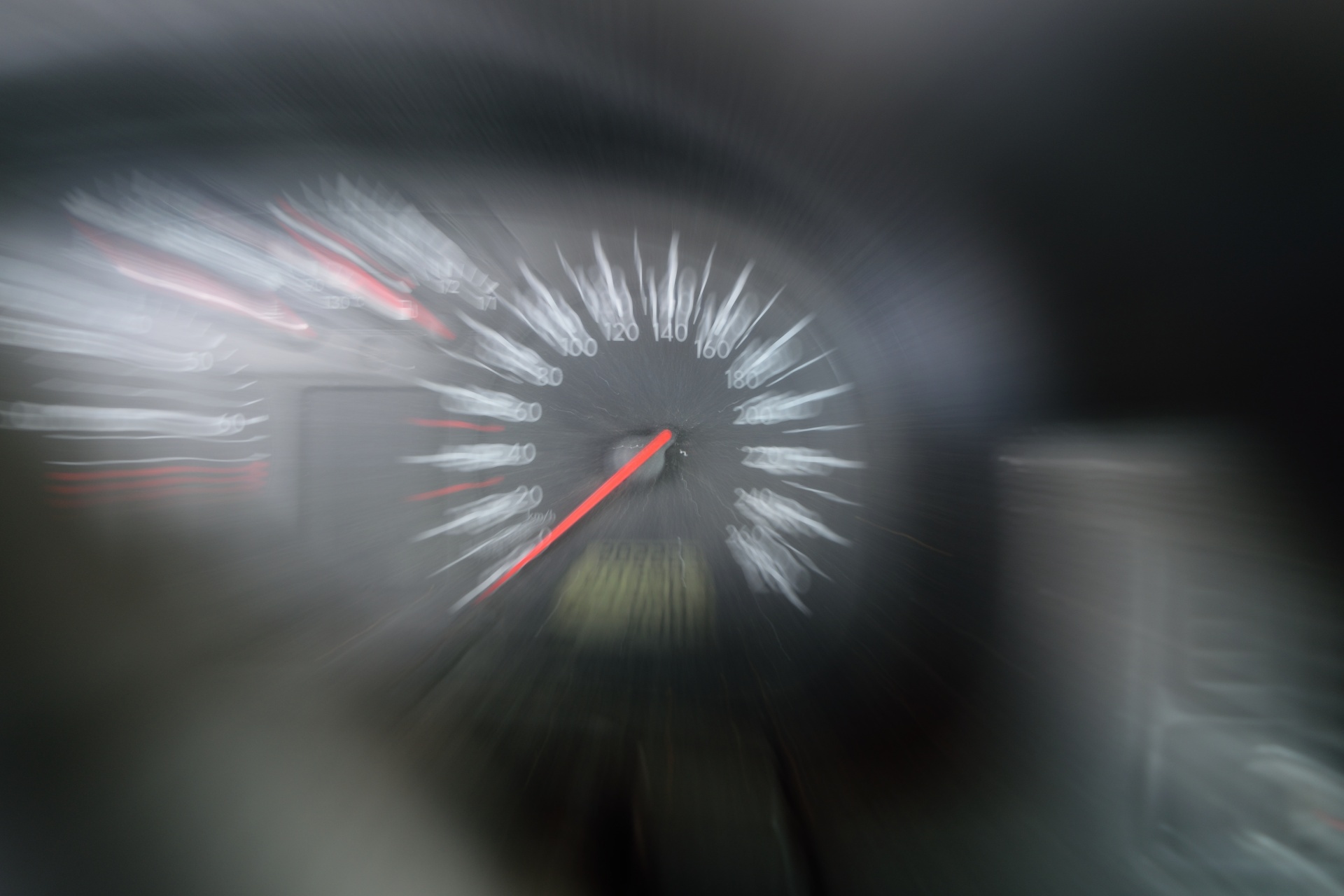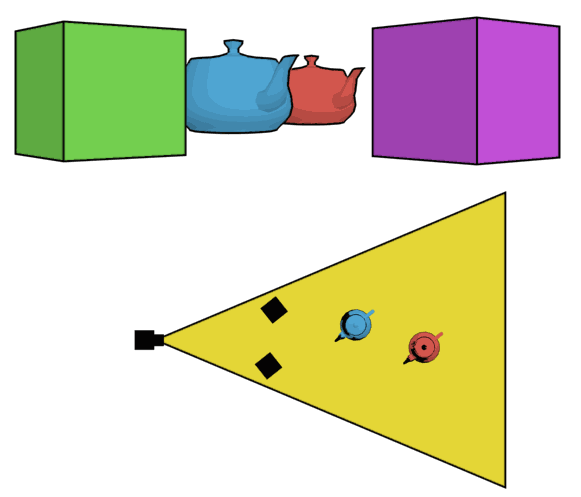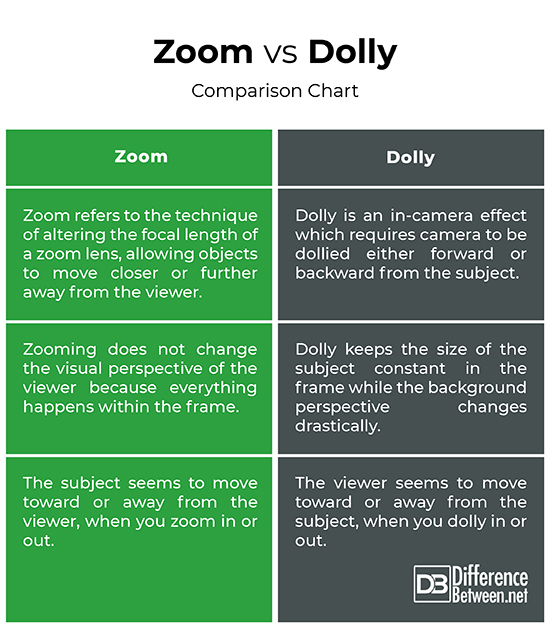Difference Between Zoom and Dolly
There are two main aesthetic principles of camera when it comes to object motion: zooming and dolly zoom. Zoom is one of the most effective and important aspects of object motion when it comes to image enhancing. It refers to the technique of changing the focal length of a zoom lens, which allows objects to move closer or further way from the viewer. Zoom, in fact, is a highly visible technique that draws attention to itself. Fast moving zooms can be as annoying as a needlessly roving camera. But, zoom is not really a camera move, but it is the flat space equivalent of the deep space dolly. Zoom and dolly are basically two types of motions in video that look quite similar, but are accomplished in distinct ways. Zooming simply means altering the focal length of the lens and is one of the most used features of most cameras, whereas dolly refers to the actual physical movement of a camera and is a more human-like approach, as opposed to zooming. We’re here to help you identify the differences between the two.
What is Zoom?
In television and filmmaking, zooming refers to the technique of altering the focal length of a zoom lens, thereby altering the angle of view, allowing objects to move closer or further away from the viewer. This is also called a zoom. It simply means getting a closer view of the far-away objects using mechanical assembly of lens elements. In general, zooming in to a close-up increases tension while zooming out releases it. Typically, it is easier to start with a close-up view of an object and then zoom out than the other way around. In zoom, the camera is not physically moving, so there is no relative movement. A zoom actually enlarges everything in the frame at exactly the same rate of speed. Zoom range is the biggest selling point for digital cameras and lenses.
What is Dolly?
Dolly, also known as tracking zoom or zolly or Vertigo effect, is an in-camera effect which requires camera to be dollied either forward or backward from the subject while the zoom lens is pulled in the opposite direction. Dolly shots involve moving the camera over a track either on the rails or on the ground, changing the position of the camera by actually moving the camera. The dolly zoom was introduced to the mainstream cinematic vocabulary in Alfred Hitchcock’s Vertigo (1958), to visualize the fear of heights experienced by detective John Ferguson at certain points in the story. A dolly typically produces more visual intensity, especially with a wide lens while a zoom usually creates less visual intensity than a dolly in or out.
Difference between Zoom and Dolly
Technique
– Zooming refers to the technique of altering the focal length of a zoom lens, thereby altering the angle of view, allowing objects to move closer or further away from the viewer. This is also called a zoom. A zoom lens simply makes the object smaller or bigger within the frame while the camera remains stationary. Dolly zoom, on the other hand, involves moving the camera over a track either on the rails or on the ground, changing the position of the camera by actually moving the camera. This helps the audience feel they are moving along with the scene.
Movement
– A zoom lens shrinks or enlarges all objects in a frame at exactly the same rate. In zoom, the camera is not physically moving, so there is no relative movement. When zooming in, all objects, regardless of their distance from the camera, increase in size at exactly the same rate. The foreground and background grow larger in unison as if everything in the picture exists on a single flat pane. On the contrary, when you dolly in or out, the viewer seems to more toward or away from the object. Dolly shots work in tandem with zoom shots so that the camera dollies in toward a subject, the lens in zoomed out, or zoomed in if the camera dollies out.
Visual Perspective
– Dolly keeps the size of the subject constant in the frame while the background perspective changes drastically, which appears to get closer or further away. A dolly shot is used in situations where a character has sudden realization, or is surprised by something or someone during a shot. In addition, dolly zoom makes the change in perspective in the background extremely noticeable when it comes to conveying extreme emotions. Zoom, on the other hand, is a highly visible technique that draws attention to itself. Zooming does not change the visual perspective of the viewer because everything happens within the frame.
Zoom vs. Dolly: Comparison Chart
Summary of Zoom vs. Dolly
In a nutshell, zooming simply means altering the focal length of the lens and is one of the most used features of most cameras, whereas dolly refers to the actual physical movement of a camera and is a more human-like approach, as opposed to zooming. So, when you zoom in or out, the subject seems to move toward or move away from the viewer. On the contrary, when you dolly in or out, the viewer seems to move toward or away from the subject. Dolly keeps the size of the subject constant in the frame while the background perspective changes drastically.
- Difference Between Caucus and Primary - June 18, 2024
- Difference Between PPO and POS - May 30, 2024
- Difference Between RFID and NFC - May 28, 2024
Search DifferenceBetween.net :
1 Comment
Leave a Response
References :
[0]Image credit: https://www.needpix.com/photo/download/1455904/zooming-zero-speed-free-pictures-free-photos-free-images-royalty-free
[1]Image credit: https://commons.wikimedia.org/wiki/File:Contra-zoom_aka_dolly_zoom_animation.gif
[2]Zettl, Herbert. Video Basics. Boston, Massachusetts: Cengage, 2009. Print
[3]Block, Bruce. The Visual Story: Creating the Visual Structure of Film, TV and Digital Media. Abingdon, United Kingdom: Taylor & Francis, 2013. Print
[4]Mercado, Gustavo. The Filmmaker's Eye. Abingdon, United Kingdom: Taylor & Francis, 2013. Print




I just have have a question which was asked in the ftti exam….which of the following is considered camera movement?
A)dollying
B)zoom
C)stilt
D)Pan
I have ticked all four .Whether all options ar right or only A and D.